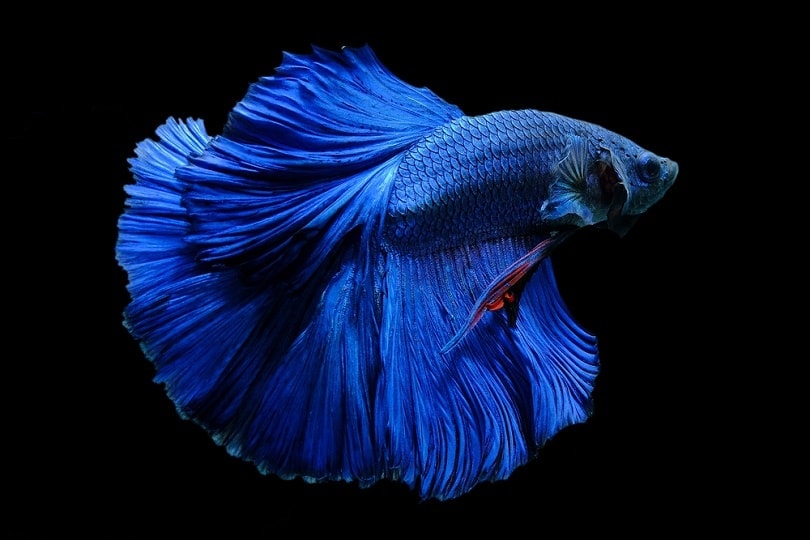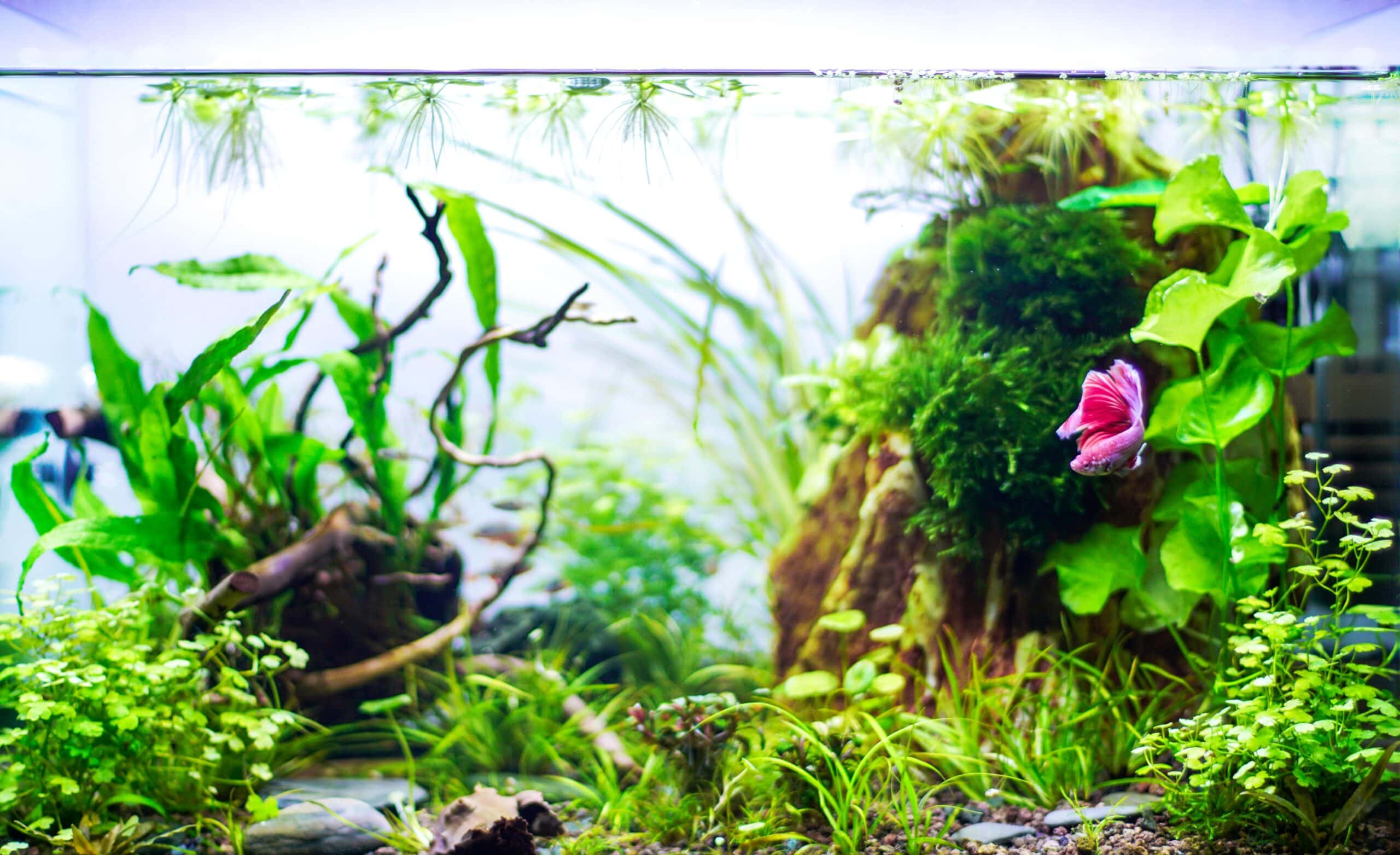How to Choose the Best Substrate for Betta Tanks

Updated on
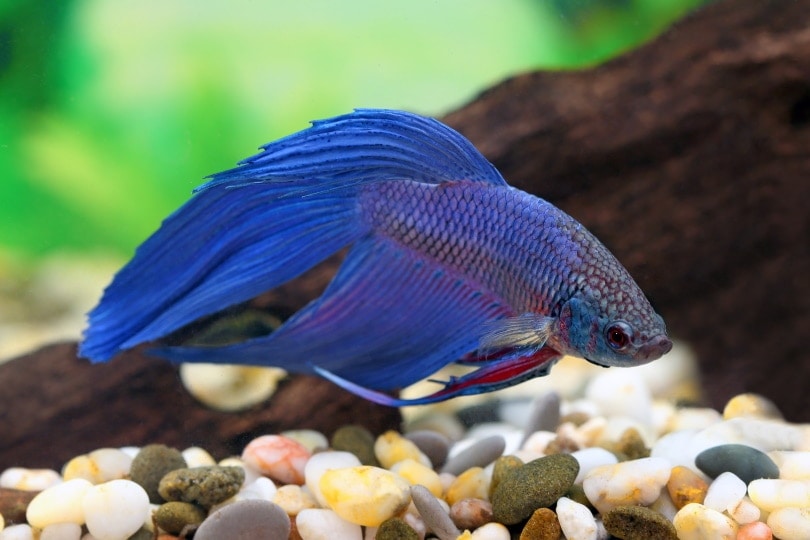
It can come as a surprise to many people just how important the substrate on the bottom of betta tanks can be. Most just look at the color and cost, without much thought being given to anything else.
And for those that do a little research, ask the right questions and try to do their best, there’s a lot of misinformation swimming out there on what kind of substrate is best for betta fish. There is a wide variety of substrate types out there; From gravel to sand, marbles to rocks and some even leave the bottom bare. But which is best for a betta?
It can be hard to make the choice—and that’s where this article will help.
We’re going to discuss what substrate is, how it affects the care of your betta, the things you need to consider when choosing what’s right for your tank and hopefully leave you confident in making the right decision.
First Things First – What is Substrate?
When it comes to fish tanks and aquariums, the substrate is the ‘stuff you use to line the bottom of your tank. It could be sand, rocks, pebbles, or many other things besides. For a literal definition, it is “A surface on which an organism grows or is attached.”
An appropriate term because in aquariums it’s where beneficial bacteria and plants attach themselves and grow. But more on that later…
Why Do We Use Substrate in a Betta Tank?
We don’t add substrate merely for visual appeal, to make our aquariums look nice. We add it because it plays many vital roles in a healthy and stable betta tank:
- Beneficial bacteria that break down fish waste colonize and cover the substrate as part of a healthily cycled fish tank.
- It provides material in which to anchor plants and decorations in your tank.
- It covers the bottom of the tank which can otherwise be reflective, stressing out particularly male betta who could flare up and try to fight their reflection.
What Substrate Would Betta Naturally Have in the Wild?
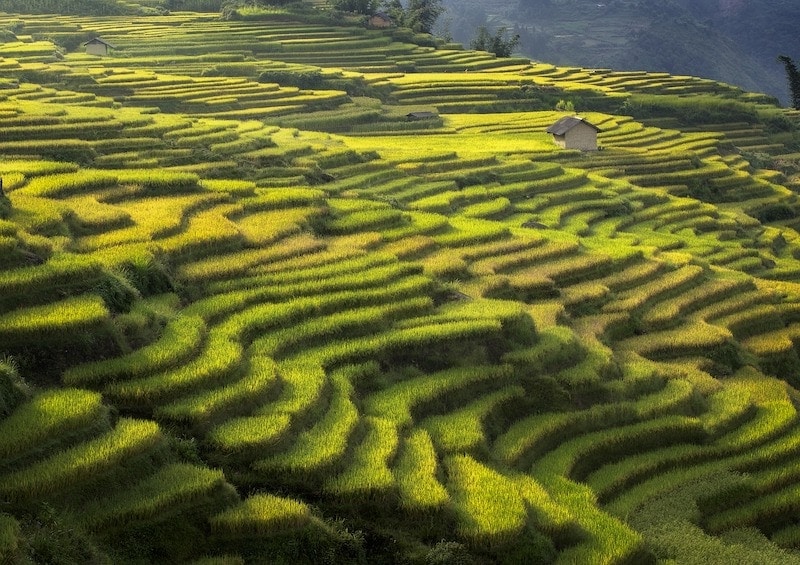
In the wild, bettas live in highly vegetated shallow waters such as drainage ditches, slow-moving streams, marshes, and rice paddies. The substrate in this natural habitat would consist of very fine muddy silt, and layer upon layer of rotting (or rotted) vegetation. In this environment, they would have plenty of overhanging plants that create shade, places to hide if they’re threatened, and even leaves acting as sleeping pads where they sometimes lay to rest.
Recreating a muddy, rotting vegetation substrate is both hard and not recommended because, with each partial water change, the water will become so cloudy you would rarely see your fish. But whatever substrate you do choose, if you want your fish to be the happiest it can be, keep in mind that it should support plants, either fake or living, for the reasons given above.
Choose natural plants or silk plants only. Plastic ones can have sharp edges that will snag a betta’s delicate fins.
Tank Size & How You Clean It
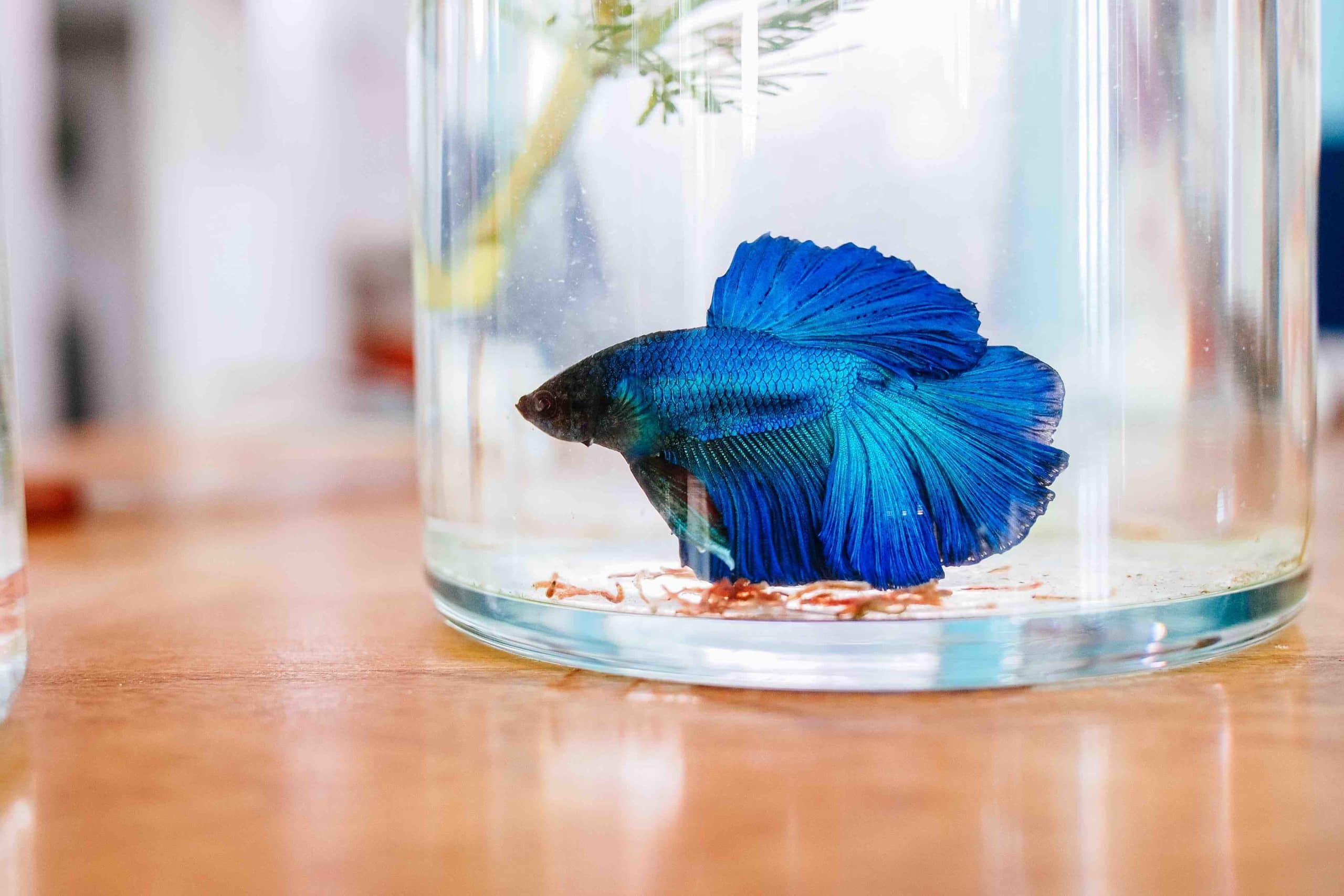
The best betta tanks are 10 gallons plus, to help stabilize water conditions, lessen the amount of maintenance work required, and possibly accommodate tank mates. However, betta tanks do come in various shapes and sizes:
If you have a very small tank of just 1 or 2 gallons and you intend to do very regular 100% water changes, sand would not be a good choice because so much will be lost with each water change. You’d be forever replacing it. So with very small tanks and bowls, marbles may be the best bet as they’re easily cleaned and returned to the tank during a water change.
In larger ‘cycled’ tanks, sand or gravel is great because they provide a large surface area for beneficial bacteria to grow.
Also in larger tanks, partial water changes—not complete 100% changes—are the maintenance routine. Waste collects on top of the sand and is easy to collect and remove with a siphon. While there are many ‘gravel vacuums’ available to help with the removal of waste that falls in between gravel.
However, if you are using large rocks or big marbles, fish waste and uneaten food can fall between them and it’s very hard to reach with any siphon or vacuum, requiring removal for cleaning.
The Popular Betta Tank Substrate Options
Choosing the best substrate for betta depends to a high degree on the setup you already have in place and the overall look you want for your tank. However, the most important thing to consider should be—which will best keep your betta fish happy?
To help you with the decision, the following is a list of the most common options along with a list of the pros and cons of each.
1. Sand as a Substrate For Your Betta Fish Tank
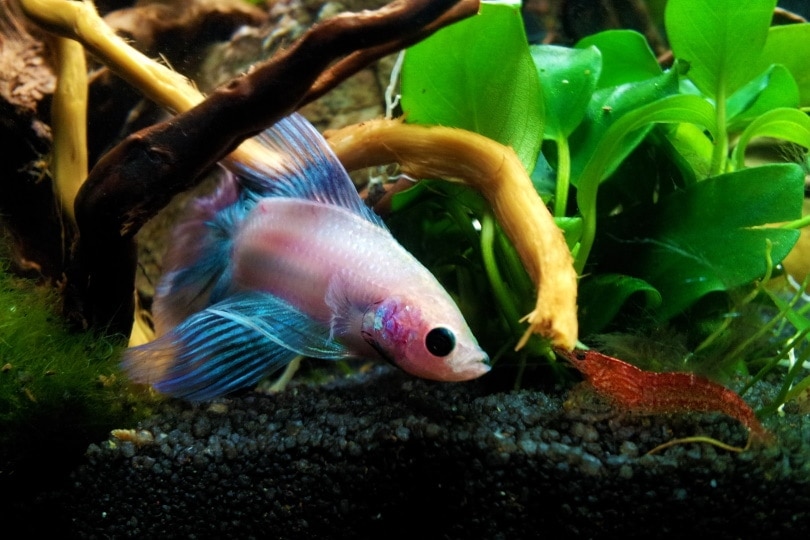
Avoid sands meant for construction, or digging it up from the beach or riverbank as these can contain harmful chemicals that can put the health of your fish at risk. You can use sand meant for pool filters or sandboxes, but it’s worth the extra dollars to buy some for the specific task at hand.
Some cons you may notice with using sand are related to the size of your aquarium and the type of sand used. But overall, good-quality aquarium sand makes for a nice substrate for a betta tank and should be one for you to consider.
- Tighter sand particles make it a relatively clean substrate when compared to other types. Debris typically sits on top of the sand instead of mixing into it, so it’s easy to vacuum by hovering your siphon an inch or so above the surface.
- Grains are small and uniform in size, so look highly visually appealing.
- Aquarium sand has no sharp edges to harm your Betta’s fins or gills should your fish decide to hunt for food in the substrate.
- It comes in many colors so you can better match or highlight your fish’s colors.
- Sand tends to swirl and mix into the water, so when you’re cleaning your aquarium, you need to be extra careful that you don’t kick up too much from the bottom and suck it out during a water change. If you do, you’ll need to replace what’s lost quite often.
- Anaerobic pockets full of bad bacteria can develop in compacted sand that generates poisonous Hydrogen Sulphide gas. Stir your sand regularly to keep this from happening. If you notice your sand turning black, change it out as soon as possible to keep your Betta healthy.
- Because sand tends to compact, some plants may have trouble extending their roots. Sand is also usually too light to hold new plants in place, so you’ll have to anchor plants down with pebbles or other décor.
2. Using Gravel As A Substrate for Betta Aquariums
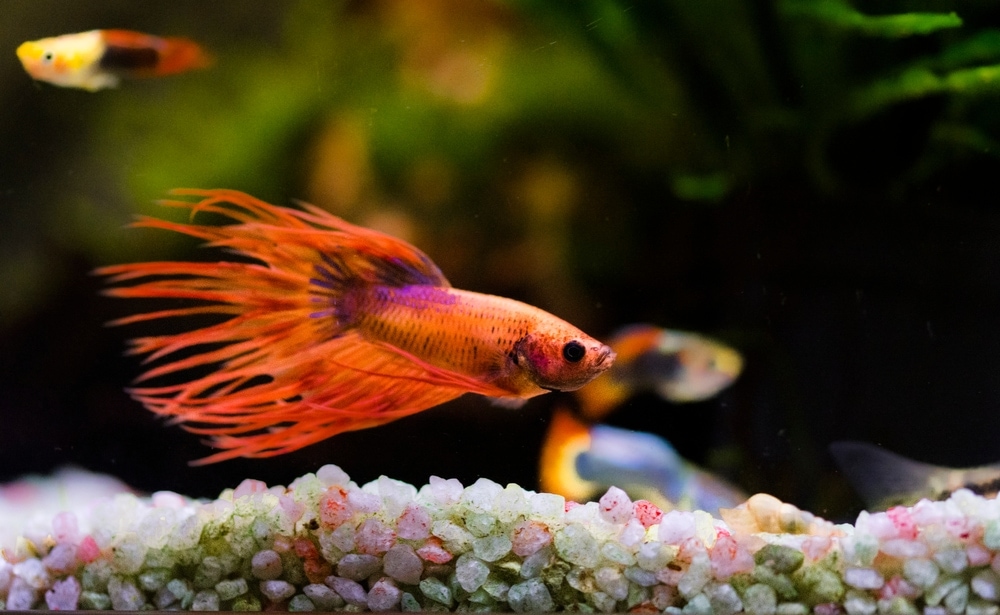
The most important thing to consider when looking at gravel as a substrate is to avoid any sharp edges as those can catch and tear a betta fish’s delicate fins. The best kind of gravel to choose is known as pea gravel—gravel that is generally the size of a pea and is nicely smooth and rounded.
- Small gravel doesn’t clump together tightly, allowing water to pass through and cutting down on the chances of anaerobic bacteria pockets building up toxic Hydrogen Sulphide.
- Although there are gaps in the gravel where food can fall through to rot, gravel vacuums are cheap and easy to use, so keeping it clean is relatively easy.
- Gravel is generally too heavy for your fish to stir up, so it won’t get sucked into filters and cause problems.
- Like sand, gravel comes in many colors and you can mix and match for a custom look.
- Gravel is not as compact as sand, so plants can grow a bit better but on the flip-side, you may find them floating away if they’re not anchored properly.
- If you’re looking for a more natural look for your aquarium, sand is a better choice than gravel.
- If you use too small gravel, you run the risk of your fish mistaking it for food and swallowing it, leading to severe medical problems.
- If you feed live food, it’s far easier for it to hide in pea gravel when compared to sand.
3. Having a ‘Bare Bottom’ – No Substrate in Your Betta Tank
While some fish really do need a substrate, it’s not as important with betta fish as they aren’t true foragers. They’ll do fine as long as they have some vegetation to hide in and rest on.
- It makes cleaning your tank much easier. You don’t have to sift through sand or gravel to clean out fish and food waste, it’s plain to see and easily vacuumed away.
- Removes all chance of your betta coming to harm by swallowing gravel or sand (which is a very, very small risk anyway.)
- The maximum space in the tank is dedicated to water. The more water there is, the more diluted waste is so is better for the fish
- No surface area for beneficial bacteria to grow
- Nothing for a betta to forage through – although not a big worry as they are more surface feeders.
- Nothing to anchor or root plants into.
- Reflections may stress fish, see-through stands even more so. Therefore, make sure the tank is on an opaque surface.
- In my opinion (yours may differ!) a bare bottom just looks unnatural and less appealing than a sand or gravel bottom
What Other Substrate Options Are There?
Sand, gravel, and bare bottom are the most popular substrate choices for betta tanks, but they aren’t the only options.
So you have a complete picture, let’s briefly discuss some of the less frequently used options and their benefits (or otherwise.)
Using Marbles to Line The Bottom of Your Betta Tank
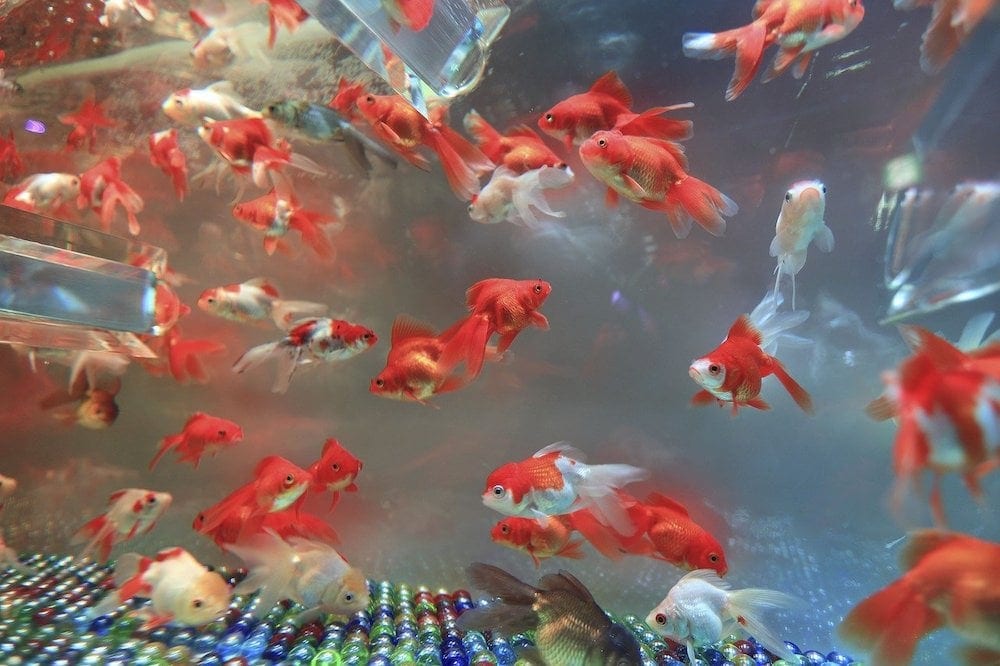
Decorative aquarium marbles for use in betta tanks are quite popular with casual keepers as they allow an endless number of opportunities to style your tank differently with so many colors and patterns of marbles available. They are good for small tanks and bowls (under 2 gallons) as they are easily cleaned during a 100% water change.
However, they aren’t good for larger tanks because food and waste fall between the marbles, and gravel vacuums are ineffective because the marbles are simply too large for them to work.
River Stones
River stones are just that—stones and pebbles that have been taken from rivers. They can give a natural look to a tank and are available in a wide variety of shapes and sizes. If using them in a betta tank, you have to be sure they aren’t ragged and sharp else they will tear the delicate fins of your fish.
River stones will not be toxic or alter the PH levels of your tank—when purchased from a reputable fish store. However, not all stones are suitable for a fish tank, which leads me to:
Stone Aggregate
This is basically sand, stones, and pebbles you simply ‘find outside’. It could be from rivers, forests or woods, embankments, construction sites—basically any stones you find lying around in nature or otherwise.
Using such stones or sand—that you simply find lying around—is strongly discouraged because you have no idea what toxins they may leach into the tank, how they will affect the PH, or even if there are harmful bacteria or parasites on them. NEVER look for stones outside and simply add them to your tank. Sometimes they can be used if the right kind and treated properly, but to be safe just buy something suitable from your local fish shop.
Substrates for Live Planted Tanks
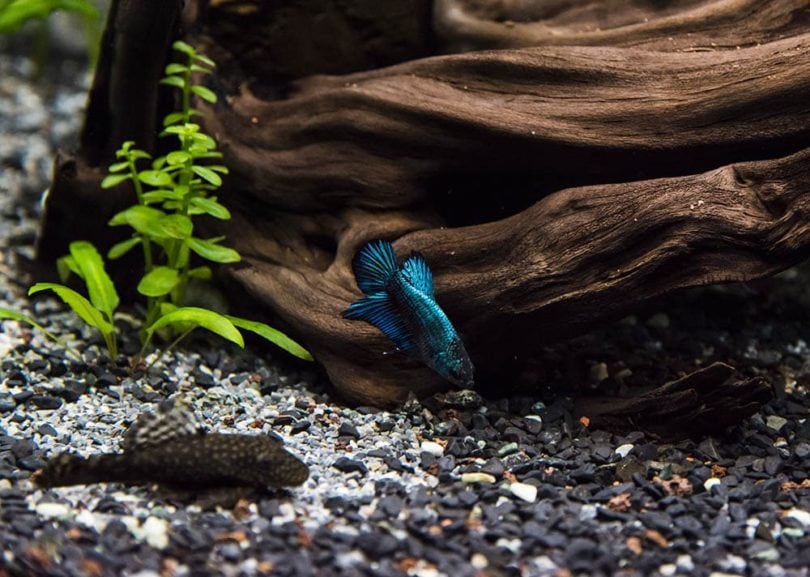
There are substrates designed and sold specifically for live-planted aquariums. These aren’t used half as much as some of the options above but with the rising popularity of hobby fish keepers growing live plants, they are becoming more common. Planting substrates are chosen—or formulated—to provide plants with all the essential elements they need to successfully grow and thrive.
They can also usually be mixed with other types such as sand or gravel, so you can have a tank with a standard look, but with a little extra to support the needs of your plants.
Please note: Just because standard sand or gravel isn’t marketed as “planting substrate” doesn’t mean you cannot have live plants. They can support plants well also, with a little extra care.
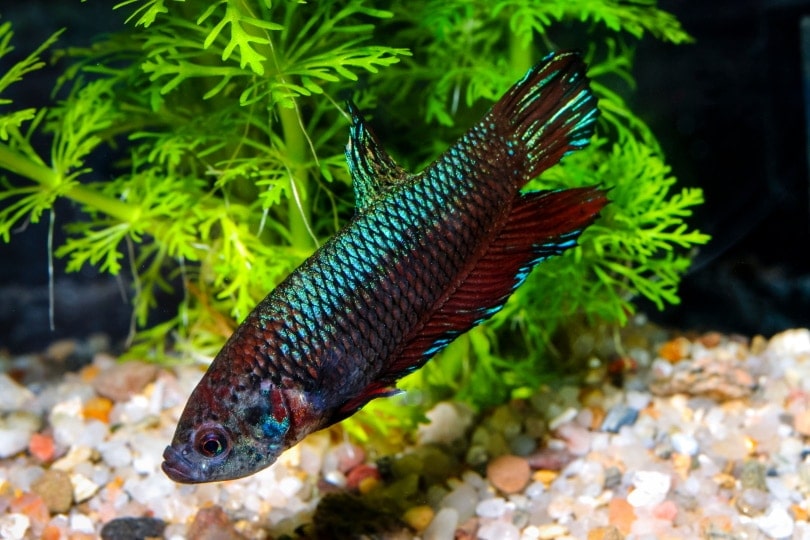
So Which is the Best Substrate for Betta Fish?
It really does depend on personal preference and what you are trying to achieve in your tank.
For small tanks and bowls under 2 gallons: We definitely recommend marbles. This is because with such a small tank, 100% water changes must be done regularly and marbles will make the task so much easier. The easier it is, the more likely you are to keep up the routine.
For larger, cycled tanks: We definitely recommend sand or gravel, for a more natural-looking tank and for more surface area for bacteria to colonize.
For planted tanks: Sand, gravel, or “planting substrate” is best to provide the plants a material for roots to spread into and to keep them anchored.
However, which you use really is up to you and we just hope the above information helps you to make a more informed decision and takes the guesswork out of it.
How Much Substrate Do You Need? What Thickness?
You probably need less substrate than you think! For tanks with artificial plants, just one inch is sufficient. For tanks with live plants, 2 inches should be used for extra anchorage and room for the plant’s roots to spread out. Also, for visual reasons, for tanks that go up to 50 gallons, 1–2 inches of the substrate is just fine. But if you have a larger aquarium, use 3–4 inches for a more balanced look.
I always think very large tanks with just an inch or two covering look a bit bare and unbalanced—but that’s just my personal opinion.
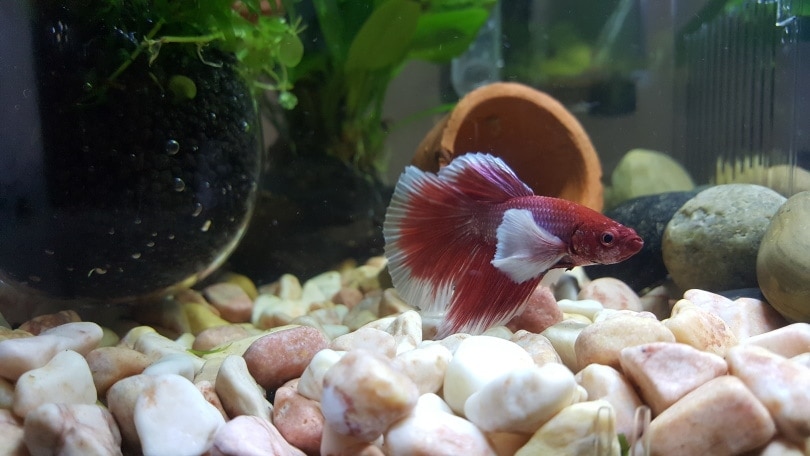
Does The Color of Betta Tank Substrate Matter?
It’s often said that betta can feel stressed with a brightly colored substrate in their tank, but I’ve not been able to find convincing evidence of this. However, in their natural environment betta fish would live above neutral, earthy-colored floors so it’s fairly safe to assume that this is what they’d do best and would feel most normal with.
Also, bright-colored substrates can be said to compete with the beautiful colors of your betta. If you have a dark or natural colored substrate, your fish will stand out more and ‘pop’ against this background, making them more visually appealing.
Final Thoughts
The substrate in your betta tank is more than just for visual appeal, it also serves a purpose. It can play home to beneficial bacteria, can anchor plants and decorations, and hence plays an important role in the health and running of your tank.
Choosing the right substrate—or whether one is needed at all—depends on some very specific details as discussed above.
We hope this article has pointed you in the right direction but if you have any further questions you’d like to ask, please post them in the comments section below. We will answer everyone.
Happy fish keeping!
See Also:
- Betta Fish Supply List: 8 Essential Items You Need to Care for Your Fish!
- 8 Best Betta Fish Foods (Freeze-Dried & Pellets) – Reviews & Top Picks
Featured Image Credit: Grigorii Pisotsckii, Shutterstock




